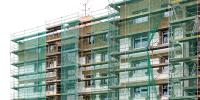CONCITO points to 18 focus areas to accelerate the green transition of the building sector – action is needed now

The building sector represents a large challenge for the climate, and the size of the sector is only expected to increase going forward, as a growing global population will all need a roof over their heads.
The climate impact from the building sector is considerable. In Denmark the building sector accounts for approx. 30 per cent of CO2 emissions, if you take the building process itself into account. Globally, the building sector's share of CO2 emissions is even larger.
Therefore, there are compelling reasons to prioritize a political focus on the reduction of CO2 emissions related to the building sector throughout the entire life cycle of buildings. This entails addressing the climate impact from building materials, CO2 emissions linked to energy consumption and construction waste, as well as enhancing energy efficiency during building operations. Transitioning towards circular processes is imperative for obtaining a more sustainable balance between the resources we extract and those we return to nature. Achieving this necessitates a focus on reusing and recycling building materials, creating new materials from recycled sources, and extending the lifespan of existing buildings to minimize the consumption of new resources.
The challenges in the building sector are well-known, and they must be addressed swiftly and effectively. To make changes happen it is necessary to initiate a systematic change where the entire value chain is addressed; from the building material utilized, to the construction site, and finally, to the use of the building.
Smaller buildings and renovation instead of new buildings
One particular area to start with is the size of a new building. The square meterage is the highest contributing factor of total CO2 emissions, primarily due to the higher consumption of materials and energy consumption associated with larger housing. Constructed square meterage is growing in Denmark, and new single-family houses now exceed 200m2 in size. The average living space is 54 m2 per person.
This trend needs to be reversed if the building sector is genuinely aiming for sustainability. We must build smaller units and we must use climate friendly, biobased materials. Given that we expect 80 percent of current buildings to still be in use in 2050, the renovation of these buildings is essential in ensuring their ongoing attractiveness, as well as ensuring their alignment with current and future sustainability standards.
Denmark must reduce the CO2 emissions considerably in order to comply with national, as well as international, climate targets and ambitions. In the publication The Climate Impact of the Danish Building Sector CONCITO highlights 18 focus areas for the building sector. Addressing these focus areas is key in ensuring an accelerated green transition of the building sector. The proposed focus areas are not limited to Denmark but could serve as inspiration for other countries as well.
CONCITO is an active participant in the work to make buildings and construction more sustainable and will follow up on this publication with more detailed findings and specific recommendations in future papers and analyses.

